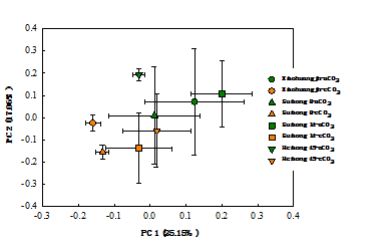Elevated CO2 is one of the main important features of future climate change. Atmospheric CO2 concentration increases can substantially stimulate plant photosynthesis and plant growth and subsequently increases the belowground carbon allocation. Consequently, the total amount and chemical composition of root exudates are likely to be altered. From a soil microbiology perspective, these alterations may induce soil biogeochemical characteristic changes and then further influence the microenvironment where the microbial communities evolve. As soil microbial communities are essential to soil nutrient transformation and carbon/nitrogen (C/N) cycling processes, any alteration in the structure of soil microbial communities under elevated CO2 (eCO2) is likely to influence plant nutrient availability, soil C-storage, and even ecosystem productivity and functioning.
Recently, researchers at Northeast Institute of Geography and Agroecology of Chinese Academy of Sciences performed open-top chambers (OTCs) to simulate the elevated CO2 . Rhizosphere soils from 4 soybean cultivars (i.e. Xiaohuangjin, Suinong 8, Suinong 14 and Heinong 45) were collected at the R5 stage for DNA extraction and subsequent next generation sequencing. The results showed that eCO2 changed the soil bacterial communities (Fig. 1). Analysis of the genera abundance (read numbers) with a two-way ANOVA showed that 15 bacterial genera were significantly (P<0.05) affected by CO2 and the extent of variation was dependent on soybean cultivars. Meanwhile, eCO2 also changed the soil fungal communities and significantly increased ITS copy numbers in the rhizosphere of some soybean cultivars (Fig. 2). Network analysis indicated that eCO2 simplified the network structure by changing topological roles of operational taxonomic units (OTUs) and key fungal members (Fig. 3), which were likely regulated by soil biochemistry properties under eCO2. The results will be helpful to predict the response of soil microbial communities to future elevated CO2 and their relationship with the soil quality in Mollisol.
These works were supported by the Key Project of Chinese Academy of Sciences (KZZD-EW-TZ-16-01), Hundred Talents Program of Chinese Academy of Sciences, Heilongjiang Provincial Funds for Distinguished Young Scientists (JC201413) and the National Natural Science Foundation of China (41201247, 41271261, 31501259).

Fig. 1. The PCoA (principal coordinates analysis) of bacterial communities in the rhizospheres of Xiaohuangjin, Suinong 8, Suinong 14 and Heinong 45 under ambient (aCO2) and elevated CO2 (eCO2) conditions.

Fig. 2. Abundance and PCoA of fungal communities in the rhizospheres of soybean cultivars Xiaohuangjin, Suinong 8, Suinong 14 and Heinong 45 grown for 65 days under ambient (aCO2) or elevated CO2 (eCO2).

Fig. 3. Zi-Pi plot showing the distribution of OTUs based on their topological roles. Each symbol representsan operational taxonomic unit (OTU) in ambient CO2 (open circles, aCO2) or elevated CO2 (closed circles, eCO2) network. The threshold values of Zi-Pi for categorizing OTUs were 2.5 and 0.62, respectively. The shared OTUs identified as generalist OTUs in aCO2 and eCO2 network but presented as specialists OTUs in eCO2 and aCO2 network were marked with bold italics.
Conatct:
Zhenhua Yu,
Key Laboratory of Mollisols Agroecology, Northeast Institute of Geography and Agroecology, Chinese Academy of Sciences
Tel: +86 15045854831
Email: yuzhenhua@iga.ac.cn, imzhenhua@hotmail.com